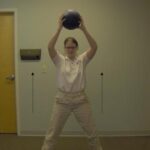Joints are generally united with soft tissue such as ligaments, allowing movement. When little or no movement occurs between the bones, the joint is made up of fibrous tissue and the two bones are held firmly together, as occurs in the skull. Movements at joints are effected by the contraction or shortening of the muscles that cross them.
Cartilaginous joints
Where only a small amount of movement is necessary, the bones are held together by a cartilaginous joint such as the pubic symphsis, where the two bones (the pubes) that make up the front part of the pelvis come together. This joint moves a little during childbirth to enlarge the pelvic cavity so that the baby may pass through. The ends of the bones in such a joint are flat thick plates covered with layers of cartilage (a firm, white, gelatin-like substance).
Other examples of cartilaginous joints are the attachment of the vertebral bodies of the spine and that between the two bones that make up the breast bone, the sternum and the manubrium sterna.
Synovial joints
The most common type of joint is the mobile or synovial joint, where considerable movement is possible. Such joints include those of arms and legs, the joints of the hand, the shoulder joint, and so on.
The ends of each bone are covered with cartilage, and the bones are attached to one another by a synovial membrane that passes across the joint, enclosing it, from cartilage to cartilage. Within the membrane is the synovial fluid, which lubricates the joint to facilitate the movements of the bones. This fluid also carries oxygen and nutrition to the cartilage.
Ball and socket joints permit movement in any direction, as at the shoulder and hip joints.
A hinge joint is a synovial joint that allows movement in one direction, such as the joint at the elbow between the humerus and the ulna. Movement ranges from the arm outstretched to the bent elbow, but not from side to side.
A pivot joint permits rotation only, such as in turning the head from side to side. The top two vertebrae of the spine articulate with each other to allow this movement.
Joint disorders are very common in all age groups. Over 15 percent of people under the age of 45 have some form of joints disorder, mostly a strain or sprain, during any twelve month period. A similar proportion of people over the age of 45 also suffer from a point disorder, most frequently some form of arthritis.
Joint injuries and short-term effects
Sprains and strains are the most common injuries of this type and occur most frequently to ankles or knees, particularly during some form of physical exertion, especially sport. A joint is sprained when the ligaments become stretched or torn. A strain occurs when excessive stretching of muscles leads to local inflammation. Symptoms of both conditions include pain swelling, and loss of function.
Direct injury to a joint may result in cuts, bruising, swelling and pain. Severe injury may affect the alignment of the bones (with or without fracture) which may be incomplete (subluxation) or complete dislocation. The ligaments and muscles are damaged, as in sprains and strains, the joint capsule fibers are often torn, and sometimes the cartilage within the joints is affected. Severe pain, deformity and loss of function follow.
Source:
Joints, www.botany.uwc.ac.za
Disorders of the Joints, www.ener-chi.com





